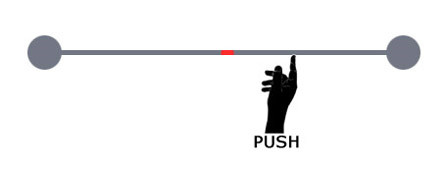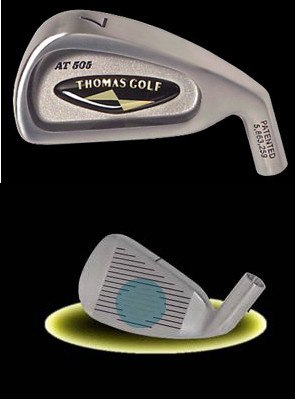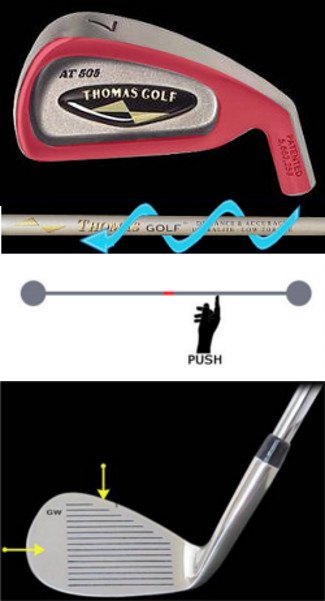
Consistently hitting the center of the golf clubface is very difficult.
In fact, about 95% of golfers typically make contact off-center. When this happens, the clubhead twists on impact, resulting in lost power and change in shot direction. Given this fact, it's easy to understand the huge success of “game-improvement clubs,” designed with specific features to boost performance of irons, drivers, fairway woods, hybrids and putters.
How They Help You:
The most important factor of game-improvement golf clubs is greater MOI (Moment of Inertia). This MOI, or “resistance to twisting,” compensates for off-center hits. In club design, greater MOI is mostly achieved via a larger head size and distributing weight around the club's perimeter. The objective is to lessen loss of power and accuracy when you miss the dead-center of the club face.
To better understand MOI and how it works, let's take the example of two simple metal bars:
An object's center of gravity will act as its natural axis of rotation (indicated above in red). If you push on a bar to rotate it, you will get more leverage (spin) when you are closer to the end of the bar. If you have a 6-inch bar and hit it 2-inches from center, you are making impact only one inch from the end of the bar. This gives you a large amount of leverage to spin the bar. On the other hand, if you push a 12-inch bar 2-inches from the center, you are making impact 4 inches away from the end of the bar. This reduces leverage and the amount the bar will spin.

Even though both bars are being pushed at a point 2-inches away from the center (axis), the longer bar gives us more distance between impact and the end of the bar, reducing leverage and spin. So, by increasing the length of the bar, we've reduced the amount of spin for an impact occurring 2 inches from center.
As you see, MOI is simply a matter of leverage. The more mass you place beyond the point of impact, the less the object will twist. So besides making the bar physically longer, this MOI affect can also be accomplished by distributing more of the bar's weight to the ends; as seen below:
This is what makes a game-improvement club so forgiving on off-center hits; larger size and perimeter weighting. Any golfer can make good use of the benefits provided by game improvement clubs with high MOI.
Click for high-MOI custom golf clubs by Thomas Golf

MOI and Game Improvement Golf Clubs
There are many different types of golf clubs on the market today. If you were to simply walk into a golf shop and tell the manager that you need a new set of clubs, he or she would have plenty of questions for you. How much experience do you have in this game? What is your average score for 18-holes? What is your budget for this purchase? The shelves of the golf shop are going to be lined with many different types of sets, so it can be a bit of a challenge to find the right clubs for your game.
One of the key pieces of the equipment puzzle is determining your current level of play. Are you an accomplished golfer, with the ability to shoot scores in the 70s on a regular basis? Or are you more of a beginner, happy to finish 18-holes with a two-digit score? Being honest in your assessment of your skills is going to make it much easier to find the perfect set of golf clubs.
Despite popular belief, you actually don't need to spend a fortune in order to set yourself up with some nice clubs. There are quality clubs available at a variety of different price points, and many of them can be used to play solid golf. Feel free to spend big on brand name equipment if you like, but know that it is certainly possible to post low scores with budget gear as well.
In this article, we are going to talk about the kind of equipment that caters to the beginners. Often, these are called 'game improvement' clubs, which indicates they are designed for those who have some work to do before reaching the higher levels of the game. As a general guideline, anyone who shoots scores in the 90s and above will benefit from the use of game improvement clubs. Fortunately, these kinds of clubs are the most popular on the market today, so you'll have tons of options when shopping for a new set. Nearly every club manufacturer in the business has their own take on game improvement equipment, including drivers, irons, and putters.
All of the content below has been written from the perspective of a right-handed golfer. If you happen to play left-handed, please take a moment to reverse the directions as necessary.

Understanding Moment of Inertia
One of the most important concepts in the world of golf equipment is MOI – or moment of inertia. While it might sound complicated at first, MOI is actually very easy to understand. The moment of inertia is the ability of an object to resist twisting. If something twists easily, it is said to have a low moment of inertia. On the other hand, something that is resistant to twisting will have a high MOI. For the purposes of golf equipment, clubs with a high MOI are going to be easier to hit, and more forgiving.
The MOI of golf clubs is a particularly important topic when talking about game improvement clubs. In the game improvement category, the goal is to make clubs which are as forgiving as possible. Beginners and high handicappers will frequently miss the sweet spot at impact, and the MOI of the club is going to determine how successful those shot will be in the end. A club with a high MOI can help the player 'get away' with a poor swing, while clubs with low MOI are going to punish the same kind of miss-hits.
If you are a high handicap golfer shopping for a new set of clubs, you are going to want to put MOI on your side. In other words, you are going to shop for clubs which have a high moment of inertia. There's only one problem – you aren't going to find the MOI of a golf club listed anywhere on its packaging at the golf shop. Of all the specs you will find when shopping for your new sticks, MOI is not going to be available in most cases.
So, how can you pick out clubs with a high MOI if you aren't able to get this information while shopping? The key is to look at the design of the club head itself. Clubs with the majority of their weight distributed around the edges of the club head are going to have the highest moment of inertia. The farther away the weight of the club moves from the middle of the club face, the higher the MOI is likely to be. With plenty of weight out toward the toe and in toward the heel, the club head will do a good job of resisting twisting, even on off-center hits.
The concept of MOI is important for all golf clubs, but it is particularly relevant when you are picking out irons. For drivers, you are going to find that nearly all drivers on the market today have a high moment of inertia. Since the club heads of drivers are hollow, all of the weight is naturally located in the sole and around the edges. That means there is a high MOI at play, and your driver shouldn't twist much even when you don't find the sweet spot at impact.
Irons are a different story, however. Since iron heads are solid, they will sometimes have rather low MOIs. This is particularly the case when you look at blade-style irons, which have a consistent thickness from toe to heel. These are clubs meant for advanced players, who are going to be able to hit the sweet spot with most of their swings. It would be a mistake for an inexperienced player to use blades, as the low MOI would mean the club head would not be very forgiving on poor swings.
The category of game improvement irons is perfect for beginners and high handicappers because of the high MOI design that they club heads use. The weight of the club is moved to the outside of the head, with a thin face design in the center. Much like the way a driver is designed, the weight of the club is pushed into the sole, as well as out to the toe and heel. In the end, this leaves you with a club that will resist twisting beautifully at the moment of impact.
When you use a set of game improvement irons, you will quickly notice that your poor shots are not punished as harshly as they would be when using blade-style irons. This is going to take pressure off of the player during the swing. Knowing that you can afford to make a minor mistake and still come away with a good shot, you will be free to make a great swing time after time. Game improvement irons are certainly no guarantee of quality play, but they are a good way to improve your outcomes while still working on refining your technique.

The Drawbacks of Game Improvement Irons
As should be clear from the previous section on MOI, game improvement irons are an excellent option for beginning golfers and high handicappers. With that said, this category of clubs is by no means perfect. There are drawbacks to using game improvement irons, and we are going to outline some of those drawbacks in this section.
The list below includes three potential drawbacks which you may experience as a result of choosing game improvement clubs.
- Loss of distance control. Game improvement clubs are designed to hit the ball long distances. That sounds like a good thing at first, and to be sure, it can be a good thing for many players. But what about when you need to hit a controlled shot that flies short of the full distance for a given club? You might have trouble on your hands. It can be hard to take distance off of game improvement clubs, since they are designed with distance in mind. For example, if you can normally hit your seven iron 150-yards, you might want to use it on a 140-yard shot to keep the ball down out of a crosswind. This is a great idea, but you may find that even a soft swing still sends the ball that full 150-yard number. As your game improves, you will likely become more and more frustrated at your inability to dial up specific yardages with a game improvement set. This is one of the main reasons that professional golfers do not use game improvement-style clubs. They could benefit from the forgiveness just like anyone else, but they do not want to give up the ability to control the distance of their shots precisely.
- Inability to shape shots. In addition to their tendency to hit the ball impressive distances, game improvement clubs are also designed to hit straight shots. Again, this is another attribute which can be a good thing in many cases. For most of the shots you hit during a round of golf, you will be happy to watch the ball fly straight through the air. But what about when you need to curve the ball to get around a tree? Or what if you want to play a draw into the green in order to access a hole location on the left side of the putting surface? In those cases, you might be out of luck. With some game improvement irons, it is nearly impossible to hit a curving ball flight on command. Just as was the case with the previous point, this is something likely to frustrate you as your game continues to improve. A true beginner won't mind at all, but a more experienced golfer will usually want to have the option to hit a curving shot from time to time.
- Difficulty developing feel for the club. In some circles, this is considered the big drawback to using game improvement clubs. Yes, they will help your performance in the short term, but what about the long-term development of your game? If the clubs are just covering up your swing mistakes, it might be difficult to actually make any progress. You'll just be left to go along with your current game, never needing to confront your swing mistakes in order to take meaningful steps toward a higher level of play. On this point, you are going to have to decide for yourself whether or not it is worth it to sacrifice short-term results for long-term improvement. If you are only interested in shooting the lowest possible scores right now, go with a game improvement set offering a high MOI. On the other hand, if you have big goals for your game and you want to develop your skills, sticking with less-forgiving clubs could pay off eventually.
In all, there is still a lot to like about game improvement clubs. They are going to help you hit the ball farther and straighter, and you should wind up with lower scores in the end. However, don't make the mistake of thinking these are the perfect clubs. They have their drawbacks as well, as highlighted by the list above. Take some time to think about the status of your game before deciding which types of clubs should be used to construct your set.






